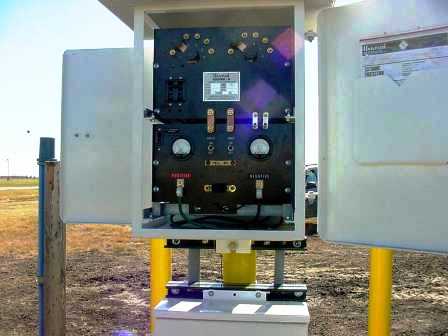What is cathodic protection?
Cathodic protection (CP) is used to control a metal substance’s corrosion in various applications. Typical applications applying this science are fuel tanks, pier pilings, ships, offshore oil platforms and casings, metal reinforcement bars for concrete structures, and pipelines.
Cathodic Protection
 To simplify cathodic protection, assume you have a metal pipeline, and you need to protect it against corrosion. We supplement pipelines with CP after being protected with an anti-corrosion system (coating or wrap), such as Trenton Wax Tape, as the primary form of corrosion protection. Otherwise, the cathodic protection required to combat corrosion for an uncoated pipeline is excessive.
To simplify cathodic protection, assume you have a metal pipeline, and you need to protect it against corrosion. We supplement pipelines with CP after being protected with an anti-corrosion system (coating or wrap), such as Trenton Wax Tape, as the primary form of corrosion protection. Otherwise, the cathodic protection required to combat corrosion for an uncoated pipeline is excessive.
The first step in cathodic protection is to take the metal you are trying to protect (pipeline) and turn it into a cathode. A pipe usually is anodic; it contains positively charged particles. By supplying an electric current, the line becomes passive or cathodic. The science reveals that corrosion will be prevented or significantly slowed as long as the flow arrives at the cathode (pipeline) faster than oxygen.
Pipelines commonly use Impressed Current Cathodic Protection (ICCP), which uses a rectifier and anodes buried in the ground. The rectifier (a DC power source) supplies electrons to the system stopping corrosion of the pipeline. Since the anodes do not surrender many electrons, they do not rust much either.
Sometimes it is more economical to use a galvanic anode system. The anodes (Magnesium, Zinc, or Aluminum) are the electron source and are sacrificed and corrode over the steel pipeline.
Products to Support CP Systems
Underground CP Test Station
The Rhino HideOut is an underground (CP) cathodic protection test station that offers excellent visibility, is durable, locatable, and installs flush with the ground eliminating mower interference.
Flange Isolation vs. Joint Isolation
Flange isolation and joint isolation are two ways of preventing electrochemical reactions from occurring between two different metals by breaking the metal path or preventing the current in the cathodic protection (CP) system from traveling beyond the area protected by the CP system.
Thermoelectric Generator (TEG) for Cathodic Protection
Thermoelectric generators (TEGs) provide cost-effective, reliable, and continuous electrical current to difficult-to-reach CP sites. If you are interested in a TEG for a CP system, Global Power Technologies specialize in them.
Anti-corrosion Systems
Trenton Wax Tape is an anti-corrosion tape that supports the cathodic protection of oil and natural gas pipelines.
The video below offers a simple representation of ICCP.


Hi Susan,
In your article you have used the phrase “positively charged electrons”. Since our understanding is that electrons are negatively charged particles, you could probably replace the word ‘electrons’ with ‘particles’
I think that makes sense. Wouldn’t that be a proton? Thanks for the input.